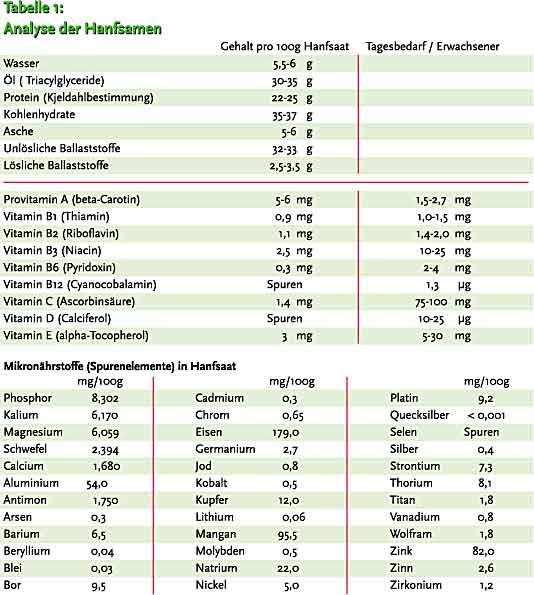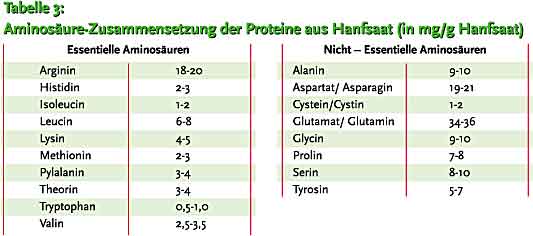
Inhaltsstoffe
Prof. Dr. Roland R. Theimer, Bergische University of Wuppertal
Hemp ( Cannabis sativa L.) is one of the few species of the plant kingdom, which has been discovered thousands of years ago for its numerous virtues and therefore it has been cultivated since then. Hemp originates from Central Asia, but has made its way through mankind into all the different climatic areas of the globe: starting from the zones with very little sun and a very short cultivation period to the subtropical-tropical zones with a lot of sun and a long cultivation period. Therefor one will find cultivations of hemp all over the world in form of hundreds of different varieties and species. Hemp has been selected over hundreds of years for its versatile virtues, like its optimal adaptation on different soils, its optimal harvest for the different hemp products and other important virtues regarding growth and cultivation.
First of all, hemp is a valuable producer of raw materials not only for the industry and trade (Fibres, hurds), but also for foods and cosmetics (Oil, Protein, Carbohydrates, Roughage, Drugs). Some of those products great value can be achieved through cultivation on poor or polluted grounds, even with poor harvesting rates. In addition cultivation of hemp does not need any pesticides and therefore one economises on material costs and labour.
Botanically hempseeds are fruits, so called nuts containing one seed, which is locked in a woody, hardy fruit shell. This seed contains an embryo (inactivated sprout), in which are placed aside the two sprouts (cotyledons), one short hypocotyl and the germ root. In the cells of the two sprouts are stored highly nutritious substances for men and animals: oil of great value (30-35%), perfectly combined proteins (mainly "Edestin"), carbohydrates (20-30%), as well as all necessary minerals and trace elements, important vitamins, chlorophylls and a few aroma substances. (Graphics n° 1)
Hempseeds do not contain any poisonous or hindering substances, as to cotton-, rape- or soy seeds and therefore can be consumed raw, hemp oil and pressed hemp seed cake do not need to be refined or pasteurised. Hempseeds do not contain the drug Delta-D-Tetrahydrocannabinol (THC, active substance in Marihuana and Hashish). THC is mainly found on the glands of the leaves in the blossom-/fruit area of the female plant. It can happen, that during the harvest of hempseeds very few resin gets stuck to the shell of those seeds. The amount is so little and conforms to European law that no problems occur. Even hempseeds of hemp species with a high THC content, need to undergo highly sensitive measurements during the oil pressing to detect any THC traces in the oil. Therefore hemp seeds do not harm your health and have no drug effect on you! Plus a quick rinse of the hemp seeds or the use of shelled hemp seeds settles all traces of THC.
In the past hempseeds have not only been known as animal (birds-) food, but also known as a perfect supplement to humans nutrition; only the nobles ignored those high physiological nutritious values of the substances in hempseeds. The well balanced ratio of poly-unsaturated fatty acids in hemp oil is ideal for the human metabolism, as well as it renders hemp into a perfect supplier for human protein synthesis, especially immunoglobulins that are important for the maintaining and strengthening of human body`s defences and therefore less prone to illnesses such as pest, cancer, etc. Porridge or butter made of ground hemp seeds contains all necessary components. In addition you can gain from cold pressing of hempseeds a dark greenish oil, of which the colour contains chlorophylls and carotinoids (Carotid=Vitamin A).
Chemically hemp oil is like all other oils a Tricylglycerid, to be more precise a glycerine molecule with three different very long fatty acids, the perfect composition ideal for human nutrition. This gives hemp oil a position of exceptional biological values. (Graphics n° 2).


The dominating fatty acid is the unsaturated Linolic acid followed by unsaturated alpha Linolenic acid. Both acids are essential for human nutrition, and therefore need to be part of the daily intake of food. You can find those unsaturated fatty acids as well in corn oil or thistle oil. Unique to hemp oil is the ratio of 1/3 of both fatty acids optimal for the human metabolism. The human body needs both of these fatty acids to support the production of regulating short living hormones, the maintenance and composition of the immune system, and the continuation of the cell metabolism. The ratio of those fatty acids is especially important for the construction of the cell membrane. The correct well-dosed use of hemp oil in human nutrition does no lead to cholesterol as quickly as compared to the use of solid vegetable fats or animal fats.
The most important component of hemp oil is the unsaturated gamma-linolenic acid (GLA) in a ratio of 1,5-6% for the metabolism depending on the hemp specie, otherwise only found in plants like Borage (Borage officinalis L.), Primrose (Oenothera biennia L.) or Blackcurrant (Ribes nigrum L.). The gamma-linolenic acid and the recently discovered Omega-3-Stearidon acid are important factors for the biosynthesis of prostaglandins, necessary factors for the functioning of hormones, nerves, muscles and blood pressure. Under normal conditions the human body has sufficient essential alpha linolenic fatty acids to produce postglandins, but... (this part is not allowed to publish by the EU competition law).
Another important aspect of the high content of over 70% unsaturated fatty acids are its perfect composition ideal for human diet. Most fats and oils with saturated fatty acids are broken down, partly turned into energy by the human body and partly stored in the fat cells (cholesterol). Thus the unsaturated fatty acids play a vital role in the synthesis of important hormones, in supporting the immune system and maintaining vigorous cells by improving the metabolism of all cells. With the absence of both cholesterols and trans fatty acids, a well balanced intake of hemp oil regulates blood lipids... (this part is not allowed to publish by the EU competition law).
Already in the Middle Ages farmers praised hemp foods. In those days hemp seeds were used for making porridge or hemp butter. The nobles disregarded hemp as a valuable food and therefore ignored hemp as a healthy additive to the human nutrition. The protein in hemp strengthens the body`s defences, due to its chemical resemblance with the immune globulins and therefore improves the immune system. The oil component in the seed is vital too due to its composition of unsaturated fatty acids and the gamma-linolenic acid. The composition of the hemp protein is 65% of the globulin Edestin and of some other albumins resembling the human blood plasma.
The composition of the amino acids in hemp seeds are similar to those of the human and therefore valuable for our metabolism although further studies still need to be undertaken in that field (biosynthesis). Not only does the protein in the hemp seed provide the body with all essential fatty acids, but also in the perfect ratio to the human body. Easily absorbed by the human body they help building up the stock of the human proteins, ... (this part is not allowed to publish by the EU competition law)

Due to its assets for a proper nutrition the protein in the food hemp seed is the perfect additive for baking, soups and other forms of food, and therefore does not meet its full value in the form of animal- or bird food. The protein is extracted in the process of pressing and grinding the hemp seeds or in the process of grinding the cake left after the process of cold pressed hemp oil (hemp cake still contain 10% oil, seed shells and other substances of the hemp seeds). The hemp flour is gained after sieving through the pressed substance in order to eliminate any outstanding shells.
Through the rediscovery of the healthy and improving nutrition with hemp, new forms of technologies have been developed for enhancing the preparation of hemp seed foods. Dehulling technologies enable to extract the seeds from its shell for the preparation of hemp foods. A process of extracting and improving the protein in the hemp seed enable manufacturers in the USA to produce a form of hemp-tofu thus hemp yoghurt and other produces. The pre- selected shells are used for the fabrication of animal foods or as filling material in cushions. In addition, there is no traceable THC in shelled hemp seeds, thus the seeds are THC-free, nor in the oil or protein, thus the only traceable THC stick to the inner side of the seed shell during the process of thrashing.
Summery:
The rediscovery of hemp as a food is not only an essential, proven progress to a healthy whole foods` nutrition, but also tasty additive to modern cooking. Growing hemp in large quantities in future will increase the amount of healthy tasty hemp foods. Such a healthy nutrition with all essential amino- and fatty acids, free from cholesterol, BSE-, GMO... hormones and destructive antibiotics is the perfect reason to step back and reflect on an thousand year old human tradition of growing hemp improved by modern technologies in both seed breeding and plant physiologies, and to throw any outstanding utopia fears of Cannabis as a drug monster over board.
The photography and contents of this home page are protected by the copyright of Hanf-Natur and partners. Die Preise verstehen sich als Nettopreise zuzüglich Mehrwertsteuer und sind nur Geschäftskunden vorbehalten. We reserve the right to correct typographical errors with regard to pricing ;-)
hanf-natur.com
Online-Streitbeilegung gemäß Art. 14 Abs. 1 ODR-VO:
Die Europäische Kommission stellt eine
Plattform zur Online-Streitbeilegung (OS) bereit, die Sie unter
https://ec.europa.eu/consumers/odr/
finden.
Besucher: 19 letzte Stunde.
Generated in 0,024 s
| Based on phpshop - ©1999-2024 by ip-medien k&l gbr
